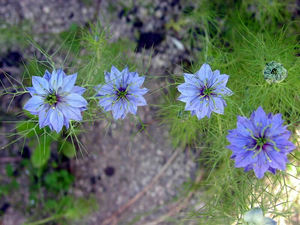
Pinyin: not known Latin: Nigella sativa
Physical Characteristics
Black Cumin is an annual growing to 0.35m by 0.2m hardy to zone 0 and is not frost tender. Black Cumin is in flower in July, and the seeds ripen in September. The flowers are hermaphrodite (have both male and female organs) and are pollinated by Bees. The plant prefers light (sandy), medium (loamy) and heavy (clay) well-drained soils that are acid, neutral and basic (alkaline). Nigella Sativa cannot grow in the shade and requires dry or moist soil.
Family
Edible Uses*
Edible Parts: Seed. Edible Uses: Condiment.*
Black Cumin Seed is used raw or cooked. Normally used as a flavouring on bread, cakes, curries, pickles etc[4, 9, 74, 100, 183]. There is a belief that eating the seed will make a woman's breasts plumper[245].*
Black Cumin seed is a very popular spice from the Mediterranean to India with a pungent flavour according to one report[46] whilst another says that it has a spicy fruity taste[238] and a third that the scent is somewhat like nutmeg[245]. The immature seed is bitter, but when fully ripe it is aromatic[9]. It is also used as a pepper substitute[4].*
Traditional Chinese Medicinal (TCM) Uses:*
Like many aromatic culinary herbs, the seeds of black cumin are beneficial for the digestive system, soothing stomach pains and spasms and easing wind, bloating and colic[254]. The ripe seed is anthelmintic, carminative, diaphoretic, digestive, diuretic, emmenagogue, galactogogue, laxative and stimulant[4, 9, 46, 238, 240].*
An infusion of Nigella Sativa is used in the treatment of digestive and menstrual disorders, insufficient lactation and bronchial complaints[9, 238]. The seeds are much used in India to increase the flow of milk in nursing mothers and they can also be used to treat intestinal worms, especially in children[254]. Externally, the seed is ground into a powder, mixed with sesame oil and used to treat abscesses, haemorrhoids and orchitis[238, 240]. The powdered seed has been used to remove lice from the hair[245].*
Other Uses
The aromatic seed contains about 1.5% essential oil[240]. It is placed amongst clothes etc to repel moths[4]. The seeds can also be put in muslin bags and hung near a fire when they will fill the room with their delicious scent[245]. They need to be changed about every three weeks[245]. The seed contains 35% of a fatty oil[74, 240].
References
- [4] Grieve.A Modern Herbal. Penguin 1984 ISBN 0-14-046-440-9
- [9] Launert. E.Edible and Medicinal Plants. Hamlyn 1981 ISBN 0-600-37216-2
- [37] Thompson. B.The Gardener's Assistant. Blackie and Son. 1878
- [46] Uphof. J. C. Th.Dictionary of Economic Plants. Weinheim 1959
- [50] Flora Europaea Cambridge University Press 1964
- [54] Hatfield. A. W.How to Enjoy your Weeds. Frederick Muller Ltd 1977 ISBN 0-584-10141-4
- [74] Komarov. V. L.Flora of the USSR. Israel Program for Scientific Translation 1968
- [100] Polunin. O.Flowers of Europe - A Field Guide. Oxford University Press 1969 ISBN 0192176218
- [108] International Bee Research Association.Garden Plants Valuable to Bees. International Bee Research Association. 1981
- [183] Facciola. S.Cornucopia - A Source Book of Edible Plants. Kampong Publications 1990 ISBN 0-9628087-0-9
- [200] Huxley. A.The New RHS Dictionary of Gardening. 1992. MacMillan Press 1992 ISBN 0-333-47494-5
- [238] Bown. D.Encyclopaedia of Herbs and their Uses. Dorling Kindersley, London. 1995 ISBN 0-7513-020-31
- [240] Chopra. R. N., Nayar. S. L. and Chopra. I. C.Glossary of Indian Medicinal Plants (Including the Supplement). Council of Scientific and Industrial
- [245] Genders. R.Scented Flora of the World. Robert Hale. London. 1994 ISBN 0-7090-5440-8
- [254] Chevallier. A.The Encyclopedia of Medicinal Plants Dorling Kindersley. London 1996 ISBN 9-780751-303148
Source: Black Cumin Seed Nigella sativa Plants For A Future, England 1996-2008.
This work is licensed under a Creative Commons License.
Natural dietary supplements are designed to offer the body support to promote health, harmony, balance and overall well being.*

 Get Well Natural, LLC
Get Well Natural, LLC  Kidney Function & Regeneration Health
Kidney Function & Regeneration Health  Platelet & Blood Cell Health
Platelet & Blood Cell Health  Prostate, Flow & Function Health
Prostate, Flow & Function Health  General Mind & Body Health
General Mind & Body Health  Heart, Cholesterol & Cardio Health
Heart, Cholesterol & Cardio Health  Allergy-Free Body
Allergy-Free Body  Anxiety & Stress
Anxiety & Stress  Blood Platelet Counts & Function
Blood Platelet Counts & Function  Blood Pressure Health
Blood Pressure Health  Kidney Health
Kidney Health  Immune System Health & Balance
Immune System Health & Balance  Prostate & Urinary Health Function
Prostate & Urinary Health Function  Blood Sugar Balance
Blood Sugar Balance  Cardiovascular Heart Health
Cardiovascular Heart Health  Detoxification & Healthy Cells
Detoxification & Healthy Cells  Women's Health
Women's Health  Liver Regeneration
Liver Regeneration  Pain-Free Body
Pain-Free Body  Water & Air Filtration
Water & Air Filtration 


